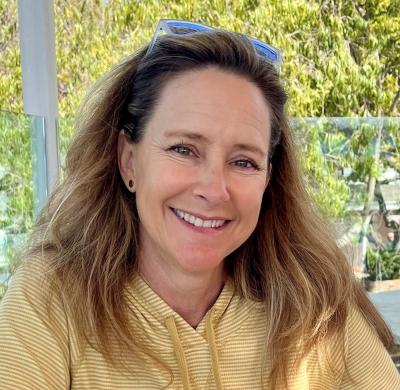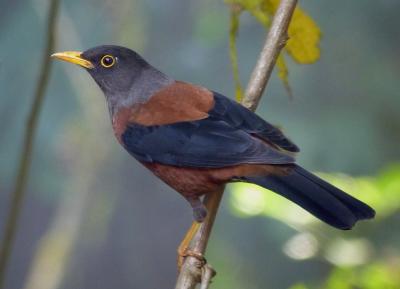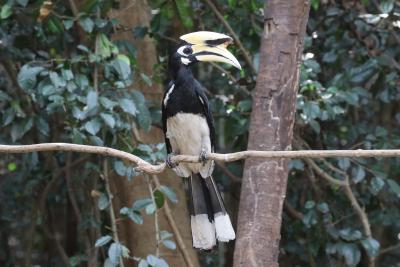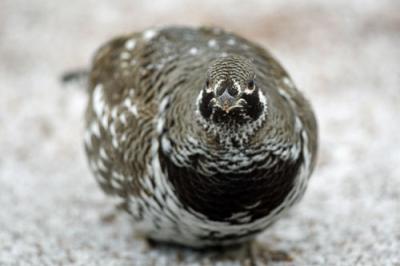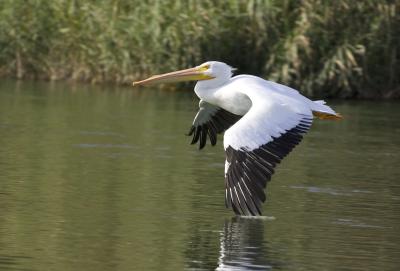Spring Migration in the Midwest
Eastern Wood Warblers
-
May 7-18, 2026
Jon Dunn and Ben Lucking
-
May 2027
Jon Dunn and Ben Lucking
2026
Single Room Supplement $990
2027
Tour Price to be Determined
2026
Single Room Supplement $990
2027
Tour Price to be Determined
There may be no better place to witness the spring passage of songbirds than the Midwest. The three main eastern migration routes converge here and since the birds are nearing their breeding grounds the males are usually in full and vigorous song. With impressive, often spectacular numbers and diversity of migrants on the best days, the Midwest is certainly comparable to any other migration region in North America. Our tour takes in two prime locations for spring migrants, Crane Creek and the adjacent famous Magee Marsh Bird Trail at Ottawa NWR (Ohio), and Tawas Point on the west shore of Lake Huron in northern Michigan, and we also spend two full days in the Carolinian forests and grasslands of eastern Kentucky and southern Ohio, where we expect to find most of the southern breeding species. Between these sites, we should see a great majority of the eastern Neotropical landbird migrants, likely including as many as 35 species of warblers, including Swainson’s and Kirtland’s—and occasionally we see, or hear, all 37 species as in 2023 and again in 2025.
Day 1: The trip begins at 2:00 pm at our motel in Florence, Kentucky near Cincinnati, Ohio. After a quick introduction meeting, we will either visit Fernald Reserve, where we have our best chance of seeing Dickcissel at the eastern end of their regular breeding range, as well as Grasshopper Sparrow, Blue Grosbeak and Orchard Oriole. Alternatively, we might visit Capability Farm in Versailles, Indiana, an area maintained for birds which consist of both grassland and woodland habitats. The Northern Bobwhite, a declining species, is found here still in decent numbers, and we are likely to at least hear it. Henslow’s Sparrow is also possible and we found three here in 2019 and had good views of one in 2023 and again in 2025. Night in Florence, Kentucky.
Days 2: We’ll depart early for the Red River Gorge east of Lexington, Kentucky in Daniel Boone National Forest, a breathtakingly beautiful place with its limestone and sandstone rock formations, some of which cross the Red River – all in a heavily forested environment. Along the way, we’ll drive through Kentucky’s “Blue Grass” and the fabled horse farms and by Pilot Knob where Daniel Boone first viewed the Blue Grass in early June 1769. Red River Gorge holds a few pairs of Swainson’s Warblers, here at the northern edge of their range, as well as many of the more primarily southern warblers such as Blue-winged, Yellow-throated, Cerulean, Pine, Worm-eating, and Hooded and Louisiana Waterthrush. There is always the remote chance of seeing Ruffed Grouse. Acadian Flycatcher and Eastern Phoebe also breed here. The forest is noted, too, for its variety of butterflies, notable among them the striking Zebra Swallowtail, which should be numerous if the weather is warm and sunny. Heading north in the afternoon we’ll stop at an industrial park in a reclaimed strip mine in Greenup County, Kentucky, not far from Portsmouth where Henslow’s Sparrow still breeds along with Grasshopper Sparrow and species such as Prairie Warbler, Yellow-breasted Chat, Blue Grosbeak, Grasshopper Sparrow and occasionally Dickcissel. Night in Portsmouth.
Day 3: We’ll spend much of the day in the beautiful and extensive Shawnee Forest close to Portsmouth, where nearly all of the southern Carolinian specialties are found in good numbers - Cerulean and Kentucky Warblers are almost common here – and we’ll probably find any we missed yesterday.
If we haven’t connected with Henslow’s Sparrow, we may try checking the fields in Adams County again on our second morning, or we may end up there late in the day in an early evening attempt for Chuck-will’s-widow, here at the regular northern end of its breeding range. In the evenings we'll look for night birds, including our only chance for Chuck-will's-widow and Eastern Whip-poor-will. Night in Portsmouth.
Day 4: We’ll depart for Crane Creek and the famed Magee Marsh Bird Trail on Lake Erie, and should arrive in time for some late afternoon birding at this premier location. By then the crowds of birders from earlier in the day should have diminished. Along the way, we may stop near Scioto Trails State Park near Chillicothie whose forested ridges have many breeding species, including Summer Tanager, and can be full of migrants. Chillicothe was Ohio’s first capital from 1803-1810 and was again the capital from 1812-1816. Night in Oregon.
Days 5-6: Crane Creek and the adjacent Magee Marsh Trail at Otawa National Wildlife Refuge are Ohio’s best migration spots. The spectacle is similar to the one at Pelee, but here the concentrations of migrants don’t seem to be as weather-dependent, and even on slower days there are usually plenty of birds. The narrow strip of woods along the lake is more open than at Pt. Pelee National Park in extreme southern Ontario, and migrants are delightfully visible. Here we can usually count on finding more secretive species such as Mourning Warbler, we might encounter an American Woodcock or two sauntering and bobbing through the wet leaf litter or a roosting Eastern Screech-Owl. Here we have our best chance of Connecticut Warbler, although the odds are only about 10%, and it may be just heard. It is by far the hardest of the 37 species of wood warblers we hope to encounter during our tour.
Elsewhere at Ottawa National Wildlife Refuge, especially on the Auto Tour, we should see a variety of waterbirds, including shorebirds if water levels are appropriate, and the adjoining woods attract migrants. If we tire of migrants, the woodlands around Toledo have a number of breeding birds, including Acadian and Willow Flycatchers and Blue-winged and Pine Warblers; and nearby Oak Openings has breeding Lark Sparrows, one of the only regular locations in the eastern Midwest. Red-headed Woodpecker breeds here too and this might be our only encounter with this striking and declining species. A few Summer Tanagers at the north end of their breeding range have recently summered here. Nights in Oregon.
Day 7: After a final morning on the Bird Trail at Magee Marsh, we’ll head north into Michigan and towards Tawas City stopping along the way to bird, perhaps around birding areas that Ben knows well around Ann Arbor or farther north near Standish. In 2025, we stopped by Lake Lansing for an adult Brown Pelican, one of the few recorded for Michigan and our first one on our Midwest Migration tours over some 45 years. Night in Tawas City.
Day 8: We’ll spend the morning at Tawas Point State Park, one of Michigan’s premier migration spots. Here the more open woodland spots make the migrants quite visible given its location, the actual migration is usually very apparent on its better days, like elsewhere the migration is best during southwest winds. There are other fine spots around Tawas City, notably Tuttle Marsh where Sora and Virginia Rail are present and we might hear American Bittern. Black Terns are also sometimes present. To the south of Tawas City we should find Clay-colored Sparrow. Lastly, Kirtland’s Warblers breed within the young stands of Jack Pine, less than 30 minutes of our hotel and we’ll search for those too. Night in Tawas City.
Day 9: This morning we might return to Tawas Point, or we will head west and then north. If we have missed Kirtland’s Warbler there are good places for them near Grayling. Upland Sandpipers and Brewer’s Blackbirds are both likely here too. Next, we’ll head North towards the iconic Mackinac Bridge, connecting the upper and lower peninsulas of Michigan. Along the way near Gaylord is another place to check for Upland Sandpiper, a declining species in the Midwest and in many other parts of their range. Before crossing, we’ll spend some time in a nearby flooded forest, home to breeding Golden-winged Warblers, as well as occasional Mourning and Canada Warblers. We’ll keep an eye on the skies here too, as raptor migration is fantastic in the vicinity of the bridge, with almost all raptors migrating through Michigan converging to cross into the Upper Peninsula here. After lunch in Mackinaw City, we’ll cross the bridge, immediately noticing the sparse population density and shift to boreal forest. We’ll make a quick stop at the nearby Point La Barbe. This can be a good lookout for lingering waterfowl such as Long-tailed Duck and Scoters and has also seen a number of vagrants over the years. Common Loon breeds here, so the night sky is often accompanied by their iconic haunting calls. Night on upper Michigan Peninsula.
Day 10: The Eastern Upper Peninsula is arguably the best birding anywhere in the Midwest. Whitefish Point is the crowning jewel, with an unparalleled track record of vagrants- everything from Shiny Cowbird to Bar-tailed Godwit has turned up in recent years. Eurasian Tree Sparrow is now annual in late May. What makes it truly special though is the migration spectacle on offer, it’s one of those rare sites that makes you realize that everything is migrating. Flocks of hundreds of Black-capped Chickadees can build up, occasionally joined by Boreal Chickadees. Thousands of Blue Jays overhead will fall in unison as Merlin’s bomb through. Warblers and finches are the often the focus early in the morning before raptors begin to build up over the hawkwatch platform. Among impressive numbers of more common raptors, American Goshawk and Golden Eagle are both regular sights through late May here. Piping Plover has also regularly bred on the beach in recent years. To top it off, there are none of the crowds found further South at sites like Magee Marsh. Lake Superior is the largest and wildest of the Great Lakes, and the picturesque wilderness along its shores makes it truly a pleasure to bird.
When we’re not birding Whitefish Point, we’ll be enjoying the enigmatic breeding species of the boreal forests. Spruce Grouse breeds at several sites near Whitefish Point, occasionally alongside Black-backed Woodpecker. A nearby spruce stand holds breeding Cape May Warblers alongside a healthy population of Evening Grosbeak. Though they can be tricky at times, this is the best site for Evening Grosbeak in Michigan. To the East, Munuscong Bay Wildlife Management Area is home to breeding American Bitterns and the occasional Least Bittern. LeConte’s Sparrow is also a tricky bird possible here. Although more difficult once they’re done lekking, Sharp-tailed Grouse are often findable on the roadsides here near Pickford south of Sault Ste. Marie, sometimes even perched precariously on telephone wires. In 2025 we found a dozen early in the morning standing in a field at the lek site. The nearby Pickford Sewage Lagoon can be productive with migrant waterfowl and shorebirds. It also supports the most consistent breeding population of Common Goldeneye in the state. Other species we will search for in the Upper Peninsula include Sedge Wren, Clay-colored Sparrow and Bobolink. Night on upper Michigan Peninsula.
Day 11: After a final early morning of birding around the Eastern Upper Peninsula, we’ll drive South towards Detroit, stopping at one or more spots along the way. Night in Romulus, near Detroit.
Day 12: The tour concludes this morning in Romulus.
Note: The information presented below has been extracted from our formal General Information for this tour. It covers topics we feel potential registrants may wish to consider before booking space. The complete General Information for this tour will be sent to all tour registrants and of course supplemental information, if needed, is available from the WINGS office.
ENTERING THE UNITED STATES: Non-United States citizens will need a valid passport and may need a tourist visa. Consult your nearest U.S. Embassy or consulate for details.
PACE OF TOUR: The tour is moderately strenuous, with long days, early departures, and moderate walks. Most mornings we’ll depart an hour after dawn or shortly thereafter. The walks at Tawas Point State Park can be lengthy, a few miles at a time (round trip) and a small portion of it might be on sand. There will be few afternoon breaks other than driving between spots. Most days we try to end our birding by 7:00 p.m. We may on occasion offer additional birding after dinner which will continue into the early evening. Still, we often don’t retire until after 9:00 p.m. so this tour can be tiring. The terrain is fairly level and usually along roads and pathways. On a few occasions, there will be the option of resting in the hotel rather than birding. However, if one has trouble walking, this tour will be difficult. There are three rather long drives on the trip as we travel to our next destination. This can be viewed as an opportunity to catch up on your rest.
RESTROOM BREAKS: Restrooms and/or porta-potty breaks will be made available throughout the tour on most days. There will be a few days on tour when a restroom break in nature will be required if needed, so participants must be comfortable with this.
HEALTH: Kentucky, Michigan, and Ohio present no real hazards to the visiting birdwatcher.
Insects and Arachnids: Biting insects are occasionally a problem in northern Michigan and possibly elsewhere if it is a very early spring. It is best to have bug repellent along just in case. We recommend using insect repellents with a high concentration of DEET. Care must be taken, however, to avoid getting the DEET repellent on optical equipment as DEET dissolves rubber and plastic and can damage coated lenses. Camping supply stores and outfitters carry some reasonably effective alternatives, which contain natural products and aren’t corrosive.
Many birders are now using picaridin, which is just as effective as DEET but not as harmful to humans and optics.
Dog ticks are present in numbers in grassland areas throughout and it is best to check yourself carefully if we walk into a field or any grassy area. These large ticks are readily visible, unlike the smaller deer ticks, and usually take their time before trying to attach, so careful inspections after walking in tick areas is well advised. It is unclear how effective repellent is in keeping them off you.
Smoking: Smoking is prohibited in the vehicles or when the group is gathered for meals, checklists, etc. If you are sharing a room with a nonsmoker, please do not smoke in the room. If you smoke in the field, do so well away and downwind from the group. If any location where the group is gathered has a stricter policy than the WINGS policy, that stricter policy will prevail.
CLIMATE: Mid-May weather in the Midwest is extremely variable with temperatures possibly ranging from the mid-30s (even high 20s) to the high 80s F. Some precipitation, perhaps heavy and possible as snow, is likely during the course of the week as various weather systems pass through and it can be windy as well. Bring warm clothes!
FOOD: Food is North American standard. Lunches will be a mix of picnics (as weather permits) and quick service restaurants.
WINGS tours are all-inclusive, and with the exception of WINGS tours to destinations in the US, no refunds can be issued for any tour meals participants choose to skip.
Food Allergies / Requirements: We cannot guarantee that all food allergies can be accommodated at every destination. Participants with significant food allergies or special dietary requirements should bring appropriate foods with them for those times when their needs cannot be met. Announced meal times are always approximate depending on how the day unfolds. Participants who need to eat according to a fixed schedule should bring supplemental food. Please contact the WINGS office if you have any questions.
TRANSPORTATION: We will be traveling by 15- [or 12-] passenger window van or minivan, depending on the group size. When using 15-passenger window vans, we will take a maximum of seven passengers plus the leader/driver. Participants should be able to ride in any seat in our tour vehicles.
PHOTOGRAPHY: Scenery and memory shots will be plentiful and simple to obtain but birds are difficult to photograph, though conditions at Magee Marsh and Tawas Point occasionally provide outstanding opportunities to photograph migrant eastern birds. We suggest a digital camera or a 35mm camera for scenes and for chance bird photographs. A telephoto lens is virtually essential for bird photography. “Digiscoping” is perfectly compatible with the tour, though you should bring your own spotting scope. Please be aware that birding tours do not provide the best conditions for bird photography as the group will move with the leader so may not be able to stay in locations for better lighting or a better view of the bird once everyone has had a chance to see the bird.
If you wish to ‘digiscope’ please ensure that you bring your own spotting scope; the leader’s scope will not be available for this purpose. Be certain to bring as many memory cards as you think you will use, as it may be difficult to find precisely what you need on short notice. Camera equipment should be packed in moisture- and dust-proof bags as a precaution.
2025 Narrative
8 - 19 May 2025
In Brief:
Our spring migration tour differed from previous years as Tawas Point State Park was closed for May 2025 due to refurbishing. We chose instead to spend three days in the Upper Peninsula. We tallied 226 species including all 37 species of eastern Wood Warblers, the Connecticut being a single bird at Magee Marsh that was heard singing. Other highlights included three species of grouse, the Ruffed being only heard and the Spruce Grouse was noted in flight, Northern Bobwhites (heard), good views of Eastern Whip-poor-will and Chuck-will’s-widow, multiple Black-billed Cuckoos, nine Marbled Godwits, two White-rumped Sandpipers, an adult Brown Pelican, a Common Barn Owl, Philadelphia Vireos, Sedge Wrens, and close views of a Henslow’s Sparrow.
In Detail:
Our tour began with a quick meeting in the lobby and then we headed west to Versailles, Indiana. Along the way we stopped for some Wild Turkeys in a field. Several Black Vultures were also seen. At Versailles we met Gary Stegner and he led us to Capability Farm where our hosts, Bob and Ellen Mulford, led us a tour of their farm, one they manage for biodiversity. We were greeted at the start by Eastern Bluebirds and nesting Purple Martins. During our walk we heard some four Northern Bobwhites, now a scarce and local species at this northern latitude. They are usually hard to see so not seeing one was not surprising. A Red-shouldered Hawk was also heard. Other species of note included Green Heron, Red-headed and Red-bellied woodpeckers, Eastern Wood Pewee, Carolina Chickadee, Tufted Titmouse, White-breasted Nuthatch, Blue-gray Gnatcatcher, Eastern Towhee, Eastern Meadowlark, Orchard and Baltimore orioles, Cedar Waxwings , Common Yellowthroats and Field and Henslow’s Sparrows. One Henslow’s was particularly cooperative, giving us excellent views. This is a scarce, secretive and local eastern grassland species. That night we had a delicious dinner at Whiskeys in Lawrenceburg in Indiana.
The next morning, we departed early for Lexington, home to Henry Clay and Mary Todd (Lincoln’s wife) and then headed east towards Red River Gorge on the Cumberland Plateau. We think we spotted Pilot Knob on the drive where Daniel Boone first saw to the west the Bluegrass region of Kentucky on 7 June 1769. At Red River Gorge we found a variety of nesting Wood warblers, which included Ovenbird, Worm-eating, Swainson’s (near the north end of its range), Blue-winged, Black-and-white, Hooded, Cerulean, Black-throated Green, Yellow-throated, Pine, American Redstart and Louisiana Waterthrush. A single Bay-breast, seen briefly, was a migrant. Acadian Flycatchers, Wood Thrushes and some 30 Red-eyed Vireos were present too along with White-eyed and Yellow-throated Vireos, an Eastern Phoebe and Eastern Towhees. Spicebush and Zebra Swallowtails were numerous. Later we headed northeast towards Ohio stopping at a bridge for Cliff Swallows for Peter. At the Industrial Park grasslands we had excellent views of Grasshopper and Field Sparrows along with Prairie and Blue-winged warblers and a Yellow-breasted Chat. After dinner we ventured west where at dusk we heard and saw a singing Chuck-will’s-widow, here the northern end of its regular range. A Virginia Possum was also seen along the road.
The next day we spent the entire day at Shawnee State Park looking mainly at breeding warblers. We started by searching for a territorial Swainson’s Warbler which was back for a 2nd summer. We did not see it, but heard it singing. This species is extremely rare in Ohio, but a few have moved north across the Ohio River in the last few years. We saw (or heard) a handful of Acadian Flycatchers and Red-eyed Vireos were common. We obtained excellent views of our last “southern” warbler, a Kentucky, tallying eight. Some 18 Cerulean Warblers were counted along with 15 Hooded and a dozen Yellow-throated, 3 Blue-winged and 3 Worm-eating along with a Louisiana Waterthrush and seven Yellow-throated Vireos. Ruby-throated Hummingbird, Spotted Sandpiper and Scarlet Tanager were all new as were a few passage migrants like Chestnut-sided and Blackpoll warblers. Two Lesser Scaup were late and out-of-place. A heard Yellow-billed Cuckoo was our only one of the trip. Early in the evening after dinner we obtained excellent views of a singing male Eastern Whip-poor-will near the lodge. A Luna Moth on the door of the lodge that morning was a real stunner too.
The next morning was a driving day and after breakfast we headed north making a stop at Scioto Trails State Park where we saw three Summer Tanagers and then continued north stopping for a roosting Common Barn-Owl east of Columbus. This species is now very rare anywhere in the Midwest. Appropriately it was roosting in a barn. An alternate plumaged American Pipit was seen farther north at a small puddle in a field. We arrived at the Magee Marsh Boardwalk at Ottawa NWR in the afternoon and saw a variety of warblers. It was not a “fallout day” but we tallied a handful of Cape May Warbles with smaller numbers of Blackpoll, Chestnut-sided, Black-throated Blue and Magnolia warblers. A single male Blackburnian almost glowed orange amongst the green foliage as did a male Prothonotary Warbler against the blue water. A few lingering White-throated Sparrows and Ruby-crowned Kinglets were present too
The migration was still slow on the 12th. We looked at mainly waterbirds while we drove the Auto Tour of Ottawa NWR. Some 80 Trumpeter Swans were tallied. This bird was introduced nearly three decades ago and they are now as common here as anywhere else. Whether they were ever native to the eastern Midwest is a matter of speculation. Other species of note during the day included a female Hooded Merganser, 15 Common Gallinules, 5 Black-necked Stilts, 6 Sandhill Cranes, 6 American White Pelicans, dozens of Common Terns, a first year Common Loon and a male Wilson’s Phalarope, the phalarope likely incubating eggs on a nest (in phalaropes, males incubate the eggs and care for the downy young) and a roosting gray morph Eastern Screech-Owl. Some 26 Marsh Wrens were tallied. These were “eastern” Marsh Wrens which have different songs from western subspecies and might well be a separate species. Migrant landbirds were few but did include a few Rose-breasted Grosbeaks and small numbers warblers which included Tennessee, Nashville and Bay-breasted. A distinctive and threatened Blanding’s Turtle was also well seen.
Overnight the winds changed and there were many migrants the next morning at Magee. We added our first Canada and Wilson’s Warblers and some 35 Magnolia Warblers were tallied during the day along with 9 Bay-breasted and 7 Blackburnians and 5 Blue-headed Vireos and our first Philadelphia Vireos (2) and Swainson’s Thrush (5). The American White Pelican numbers had grown to 18. Later in the morning we were alerted to the presence of a Virginia’s Warbler, a first for Ohio, at Wendy Park in Cleveland and we chose to chase it. There were many looking for it, but it had moved on. Still there were many migrants present including another Black-billed Cuckoo and a male Mourning Warbler, our only one of the trip. A Savannah Sparrow there in the park was very blackish and was likely the subspecies oblitus which breeds at Hudson Bay.
This morning we returned to Magee where we were alerted that a singing Connecticut Warbler was present at the entrance to the Bird Trail. When we arrived there the bird was still singing, but it eluded observation and then flew east further into the middle of the woodland. We heard it sing again later in the morning, but it was far from the boardwalk. This is the hardest eastern warbler to get. Most of the time we miss it. This was a good audible though. A Philadelphia Vireo was also seen along with six Blackpoll Warblers and 29 Tennessee Warblers. From here we went up into southeast Michigan where we found both Lark Sparrow and Blue Grosbeak, rare and local species in this northern state. Three Henslow’s Sparrows were also heard, and 29 American Pipits (all in alternate plumage) were noted in a fallow field. From there we drove north to Lansing where an adult Brown Pelican was present, one of the few that have been recorded in the state. It was still there, apparently on its last day there. From Lansing we drove north, stopping near Grayling to look through waterfowl. We noted a Ring-necked Duck, 14 Redheads and five Black Terns. We overnighted in Grayling. In previous years we would have ended up at Tawas City on Lake Huron for four nights, but Tawas Point State Park was closed for the month of May! Thus, we adjusted our itinerary to include the Upper Peninsula. We overnighted in Grayling.
A few of us went to a marsh not far from Grayling to see if we could hear Yellow Rail. We mostly just heard traffic noise! The following morning after breakfast we went southeast to a large stand of young jack pines, perfect habitat for Kirtland’s Warblers. We saw or heard 28 Kirtland’s. We also recorded Brewer’s Blackbird and Vesper Sparrow in the area along with a singing “Slate-colored” Junco. From there we headed to near the Mackinaw Bridge where we had good views of territorial a Northern Waterthrush and a male Golden-winged Warbler. A Ruffed Grouse was heard drumming. Birding around the Straits of Mackinaw we located Canvasback, Long-tailed Duck, and Common and Red-breasted mergansers. On the north side there was a good-sized colony of Ring-billed Gulls. Continuing on to Trout Lake on the Upper Peninsula we stopped for a perched adult Broad-winged Hawk and had an American Bittern fly across the highway. We arrived at Trout Lake and Birch Lodge late in the day. Built in the early 20th century, this two-story structure was built as a sanitarium for those suffering with tuberculosis, but was soon converted into a luxury hotel which it remains today.
The next morning, we left well before dawn and drove east for a Sharp-tailed Grouse lek site near Pickford, south of Sault Ste. Marie. It had rained heavily overnight and was still raining which made the dirt roads a bit iffy in places. When we arrived, the grouse were on site, but were not dancing. We counted a dozen. After enjoying the grouse, we went to Pickford for breakfast at a bakery and then checked some nearby ponds and agricultural areas. We noted a small number of shorebirds including good comparisons of Greater and Lesser Yellowlegs and six Wilson’s Phalaropes. A Short-billed Dowitcher showed the characters of the nominate subspecies, griseus, which mostly breeds east of Hudson Bay. The more numerous subspecies in Michigan is hendersoni which breeds from Hudson Bay and west toward northern Alberta. Displaying Wilson’s Snipes were also present along with Sandhill Cranes, a few Northern Harriers, several Belted Kingfishers and a handful of Bobolinks. An American Bittern was heard. From there we headed west and then north to Whitefish Point which is one of the most famous birding locations on the continent. The winds were out of the south and the raptors were flying. There was also some fog initially, so we found ourselves just hearing a Red-necked Grebe off the point. During our time there we estimated some 300 Sharp-shinned Hawks along with a half dozen Broad-wings and three somewhat late Rough-legged Hawks. Merlin and several Bald Eagles were noted as well along with an abundance of Blue Jays (some 1000). At the feeders were numerous Black-capped Chickadees (nearly 50). Two female Evening Grosbeaks made an appearance. Also abundant around the feeders were White-crowned Sparrows. Amongst the eastern subspecies, leucophyrys, was a single gambelii which breeds to the west of the range of leucophyrys. We then did a bit of birding to the south of Whitefish Point where we had nice studies of Golden-crowned Kinglets, a Yellow-bellied Sapsucker and a Hermit Thrush. A female Spruce Grouse flushed (much shyer than the males) from along the side of one of the dirt roads.
The next morning, we first checked Hulbert Bog where we located Winter Wren and then headed north to Whitefish Point. It was covered by fog, so we didn’t linger long, but did note a female type “eastern” Purple Finch perched above the feeders. Two Pine Siskins and an Orange-crowned Warbler (northern celeta subspecies) were also seen. The Orange-crowned was our 37th species of Wood Warbler, a full sweep of the eastern slate of available species, although the Connecticut was only heard. Merlins also passed through. Later, we birded marshy and agricultural areas south and east. Species of note included Clay-colored and Lincoln’s Sparrows, some 22 Bobolinks, Red-breasted Nuthatch, two Black-billed Cuckoos, and three Sedge Wrens. A single Sharp-tailed Grouse and one Ruffed Grouse was heard drumming. Two Snowshoe Hares were also seen.
Our last day was mainly a driving day back to Detroit, but we made numerous stops, the first of which was a farm pond on Morgan Road near Gaylord. Here we finally located the pair of Upland Sandpipers. After brunch in Grayling we checked the Houghton Lake Flats where we noted Black Terns and then to Nayanquing Point State Wildlife Area where a colleague of Ben’s had located Marbled Godwits, a rather rare species in Michigan. Nine godwits were assembled. Also present here were Virginia Rails, Forster’s Terns, a Black-crowned Night Heron, Marsh Wrens and Yellow-headed Blackbirds along with 11 Black-bellied Plovers Also of interest was a dark Plegadis ibis which appeared to be a hybrid between Glossy and White-faced Ibis. Any ibis is rare in Michigan. Hybrids between these two closely related species are frequent. Several Ring-necked Pheasants were heard. From here we drove south to Bay City State Park where numerous shorebirds were present on the mudflats at the lake’s edge. These included two White-rumped Sandpipers along with several Semipalmated and numerous Least Sandpipers. A few of us walked right up to the White-rumps. Numerous Dunlins and Semipalmated Plovers and three Ruddy Turnstones were also present along with a half dozen Bonaparte’s Gulls. From here we headed south to Ann Arbor and the Broadway Street Bridge where we studied Cliff Swallows and then dined nearby at Bigalora Wood Fired Cucina. After dinner we headed east to our hotel in Romulus near the Detroit Metro Airport. After check-in we headed west again near dusk to Le Furge Nature Preserve. We stopped near there to study two Common Nighthawks, our first ones on the trip and had good audible songs of Willow Flycatchers. Our main purpose there was American Woodcock and they soon started displaying. We had good flight views and studies on the trail as well.
In total we had 226 species, our largest Midwest Migration total ever. Adding the Upper Peninsula of Michigan no doubt was largely responsible. My thanks to my co-leader, Ben for all of his assistance especially in Michigan, in his beloved Washtenaw County and throughout the rest of the state.
- Jon Dunn, 2025
Maximum group size 9 with two leaders. Both leaders will join regardless of group size.



























